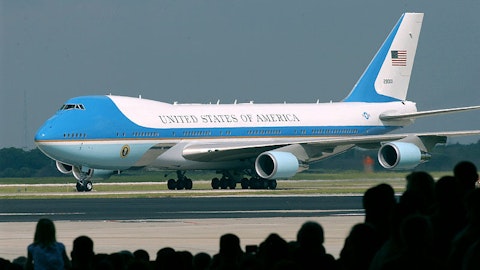Seth Seifman: Right, right. And as far as that stability that you’re looking for, how much at this point would you say needs to come from improvement in the supply chain versus any improvement that’s necessary in the internal productivity?
Dave Calhoun: Yes. Look, I don’t want to suggest that we don’t have our own opportunities internally. We do, mostly driving cycle out and creating buffers in the right positions, et cetera, all things that you would a cash flow company that really practices lean. So we will make improvements there. But the lion’s share of the rate discussions is going to be built around the supply chain and the capacity, literally the capacity and capability of that supply chain to meet the new rates. And as I said, very transparent discussions. It’s almost entirely built around labor availability, trained labor ability as we move through the course of the year. Hiring is not a constraint anymore. People are able to hire the people they need. It’s all about the training and ultimately getting them getting them ready to do the sophisticated work that we demand.
Seth Seifman: Thank you.
Operator: And next, we go to Cai von Rumohr with Cowen. Please go ahead.
Cai von Rumohr: Yes. Thank you very much. Could you update us on your efforts to certify the MAX 7 and 10 as well as the 777X? And as part of that, the agreement to allow you to push out the certification date of the 7 and the 10, I think you agreed to backfit some software changes on the existing MAX fleet. Could you tell us how much that’s likely to cost? When did you take the accounting impact? Thanks.
Dave Calhoun: I’ll take the last part of that to get that off the table. The provision to retrofit the fleet was taken in the fourth quarter. That’s behind us. It was small. And there’s a reason why it’s small. But I just — I hope everybody knows and understands how important it was to get those extensions in place in the legislation. The argument was purely a safety argument. Fortunately, we got a lot of support on both sides of the aisle, and we got it done. So this gives us all the flexibility we need to get these airplanes certified under the existing applications and we feel good about that. We think first flights for the 7 will be this year and probably for the 10 next year. So we like where that stands. Everybody’s calm, the FAA, nobody ever put pencils down.
So we’re just going to progress. And like always, we’re not going to tell you exact dates as to when we expect those certifications. So all feels good. And then yes, the legislation that was approved included some improvements that we put into our cockpit on the DASH10 that everybody agrees are useful and helpful to pilots. And those largely software adjustments will be incorporated into the entire MAX fleet over several years. As Brian said, it’s not a large number, but we provided for it, and we’re confident we can meet those objectives provided the CERT and those improvements are accomplished here in the next year or two.
Cai von Rumohr: And the 777X?
Dave Calhoun: No, I’m sorry. Everything is on course for the 777X. And I think the only issue that has created some concern over the last couple of years has been our agreement with the ASO and some of the design principles that we think we’re making terrific progress with ASO. And I think we will have a coordinated regulatory approach to the set, and so we’re staying on our targets.
Cai von Rumohr: Thank you.
Operator: And next, we’ll go to David Strauss with Barclays. Please go ahead.
David Strauss: Thanks for taking the question. Good morning. Could you touch on the large pickup in 787 deferred the balance in the quarter, what that means going forward for the cash outlook on the 87? And also, Brian, if you could just touch on the big pickup that we saw in the BCA unit loss, is that just related to the higher 787 deliveries in the quarter? Thanks.
Brian West: Yes. On the deferred production balance, that’s basically the 787 cost base extension that I mentioned has an impact on program margins, and that’s amplified by all the finished goods inventory that’s sitting there on the under airplanes. So that’s driving the increase. And your last question, basically, it’s impacted by customer mix and the impact of customer concessions and considerations.
David Strauss: Okay. And a quick follow-up on the — I think you said 138 China airplanes in inventory. Are you still looking to remarket those?
Dave Calhoun: Yes, but only partially. And as of now, when you see the sort of the results of that effort, you can assume that will be on pause with respect to that until we get — until we understand completely where China wants to go. So the answer is yes, and you’ll see progress but you’ll also see a pause so that we can discern what China wants to do. And hopefully, that’s good news.
David Strauss: Thank you.
Operator: Our next question is from Jason Gursky with Citi. Please go ahead.




